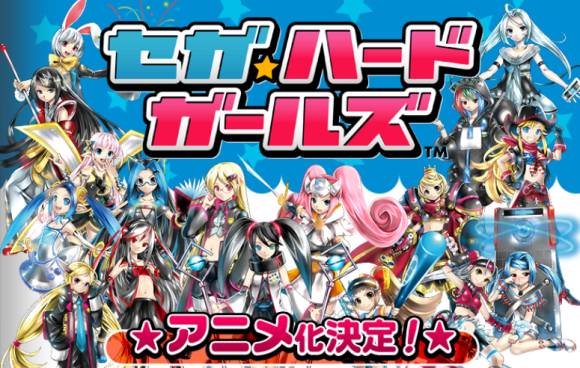
Perhaps it says something about the fundamental goodness of the human heart that once someone is no longer with us, we tend to remember the good things about him or her. Even though the memories of petty differences and irritants tend to fade with time, the happy moments often remain with us, sometimes picking up an even warmer aura as nostalgia colors them.
The phenomena doesn’t just happen with people, though, but video game hardware too. This partially explains why Sega, which discontinued its most recent console well over a decade ago, is seeing a new anime being produced in which the main characters are cute, anthropomorphized versions of the company’s defunct video game systems.
Ironically, the all-female core characters of the Sega Hard Girls multimedia franchise haven’t yet had their own dedicated video game. They’ve made guest appearances in other titles, though, and there’s also a continuing Sega Hard Girls novel serialization which started last summer.
The series packs a one-two punch consisting first of the old-school appeal of paying homage to consoles that attracted extremely dedicated fan bases, even if in the end their numbers weren’t enough to convince Sega to stay in the hardware business. And of course, as with so many successful Japanese pop media venture, the series packs a full selection of cute but non-threatening girls.
Each of Sega Hard Girls’ principal young ladies is inspired by a different piece of Sega hardware. Not only do their birthdays synch up with the day each console went on sale, their visual designs and backstories incorporate a number of cues from their respective namesakes. For example, not only does the expressive Dreamcast’s hairstyle resemble that of unofficial system mascot Ulala from rhythm game Space Channel 5, she’s also gotten used to dealing with poverty, no doubt a subtle reference to the system’s lackluster sales.
Sega Saturn’s black and white ensemble harkens back to the two colors the console of the same name was available in, and while the Saturn logos on her two rods are the most eye-catching, the S motif also shows up on her oversized necklace/chocker and boots. She’s described as acting like nothing fazes her, despite secretly always striving to do her best, akin to how the system’s peak performance came when all eight of its processors were working in tandem.
As the first 16-bit home console, Sega’s Mega Drive, renamed Genesis for its North American release, represented a huge leap forward in processing power, so it’s fitting that Sega Hard Girls’ character of the same name would be described as intelligent and analytical. The system also just happened to be involved in the longest, bitterest console war video gaming has ever seen, in its long battle with rival Nintendo’s Super Famicom/Super NES, which helps explain this young lady’s competitive streak.
Her barrette is clearly modeled after the three-button layout of Sega’s 16-bit controller, but what American gamers might not know is that the maroon trim on her outfit matches the dab of color on the top of the Mega Drive console, which was changed to crimson for the Genesis (presumably because red is more XTREME!).
Being based on Sega’s portable system, Game Gear has the diminutive frame you’d expect, plus her colorful locks are a match for the system’s tri-colored log. With a full-color and backlit screen, the Game Gear tended to go through batteries faster than the rival Game Boy, which is reflected in the character’s routinely low energy level.
Calling it a system is stretching things a bit, but the Dreamcast’s memory card did have its own display and buttons, and could be used to play simple minigames. The peripheral’s representative character, Visual Memory, is predictably good friends with Dreamcast. Visual Memory is even able to shrink down to a size tiny enough that she can rest inside the controller Dreamcast uses as a helmet, much like how the Dreamcast system’s memory card was inserted into a slot on the controller.
Most biting of all is the character description for Super 32X, whose connected system lost the “Super” portion of its name in territories outside of Japan. The majority of gamers would say the nominal downgrade was appropriate, as the 32X add-on was a blatant attempt to squeeze one more year of life out of the Mega Drive, and what little support Sega gave to the peripheral disappeared at almost the exact instant the company’s Dreamcast console was ready to launch.
So how does this tie in to Super 32X’s personality? Well, she enjoys teasing people, fast-talking them, and even when she’s caught doing something wrong, she’ll offer a litany of excuses before she apologizes. Sounds spot-on to us.
Last, and while not least, certainly most obscure, is TeraDrive. Released three years after the Mega Drive’s debut, the TeraDrive system was a PC with an integrated Mega Drive console, manufactured by IBM, of all companies, which have effectively zero impact on both the PC and video game worlds, and was almost instantly and completely forgotten.
Given this background, one can see why the character TeraDrive, despite her considerable information sorting capabilities, is prone to bouts of delusional romanticism that don’t exactly pan out.
The Sega Hard Girls official Twitter account says it will reveal more details to fans as they become available, but currently specifics are scarce. An air date hasn’t been announced yet either, although it’s probably a safe bet that we’ll see the first episode of the anime long before Sega’s next game console.
Source: Jin
Top image: Sega Hard Girls
Insert images: Jin

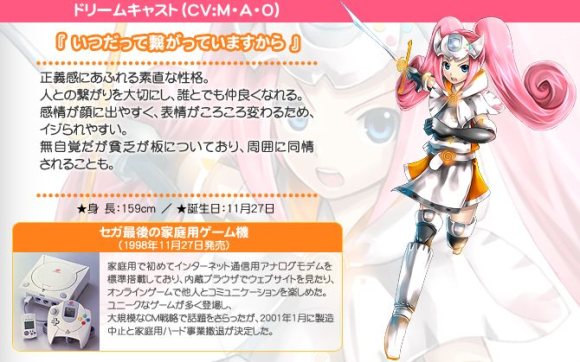
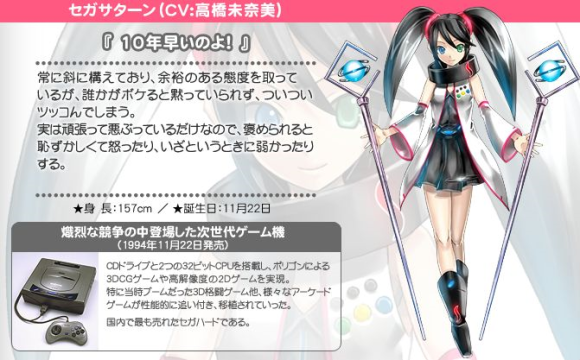
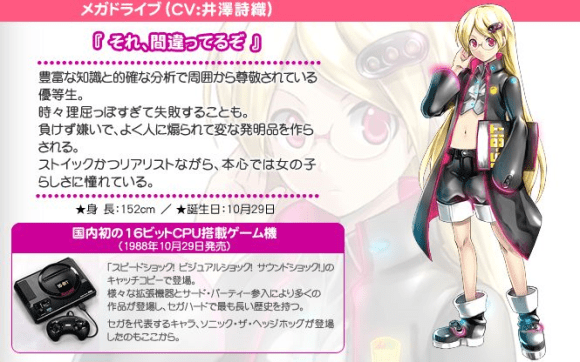
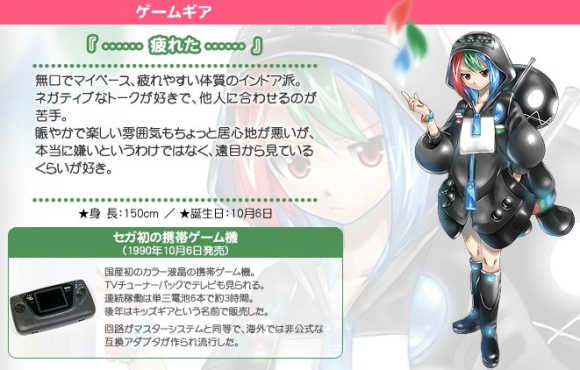
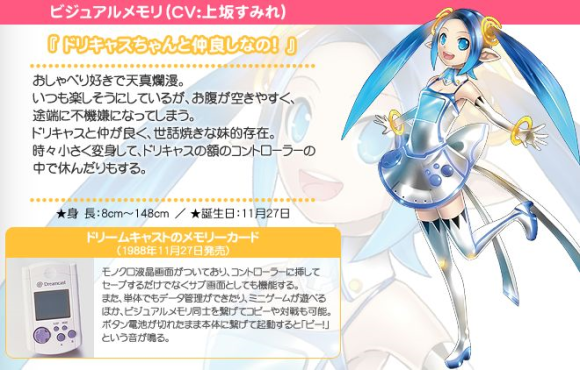
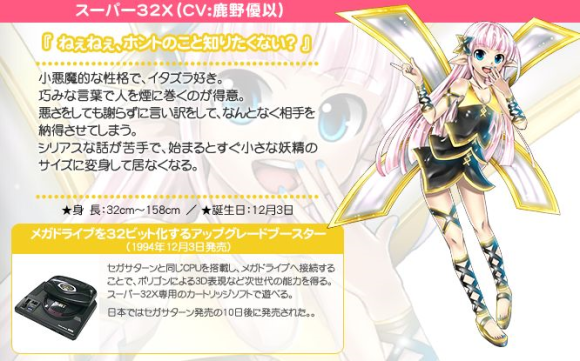
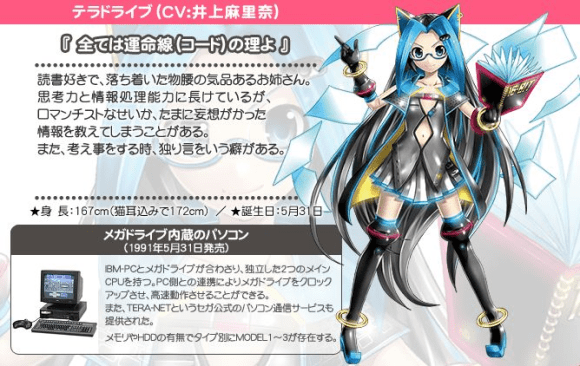
 Sega’s Mega Drive/Genesis lives again, is back in production 28 years after its initial launch
Sega’s Mega Drive/Genesis lives again, is back in production 28 years after its initial launch Scale SEGA! Game company’s greatest consoles recreated in miniature for your figures to play with
Scale SEGA! Game company’s greatest consoles recreated in miniature for your figures to play with Sega announces Game Gear Micro, an extra-tiny retro system with a startingly high price
Sega announces Game Gear Micro, an extra-tiny retro system with a startingly high price Cuddly Sega Mega Drive plushie, Dreamcast hoodies and more on sale at this year’s Tokyo Game Show
Cuddly Sega Mega Drive plushie, Dreamcast hoodies and more on sale at this year’s Tokyo Game Show Sega builds “world’s fastest gaming PC,” is giving it away for free (processor speed unknown)【Vid】
Sega builds “world’s fastest gaming PC,” is giving it away for free (processor speed unknown)【Vid】 Changes to Japan rail pass make it fall out of favour with travellers
Changes to Japan rail pass make it fall out of favour with travellers We visit the restaurant chain with more stores than either McDonald’s or Starbucks
We visit the restaurant chain with more stores than either McDonald’s or Starbucks First One Piece Day outside of Japan draws huge crowds
First One Piece Day outside of Japan draws huge crowds McDonald’s Japan renews the Samurai Mac, but not everyone will be happy with the new warrior
McDonald’s Japan renews the Samurai Mac, but not everyone will be happy with the new warrior Studio Ghibli announces new anime short in production, now recruiting staff to make it
Studio Ghibli announces new anime short in production, now recruiting staff to make it Swinging an umbrella while walking has same force as a piano, Tokyo government claims
Swinging an umbrella while walking has same force as a piano, Tokyo government claims Japanese convenience stores get old-school elegance with their own tokonoma alcoves【Photos】
Japanese convenience stores get old-school elegance with their own tokonoma alcoves【Photos】 Tokyo trains now have new first-class Green Cars, but are they a sell-out hit?
Tokyo trains now have new first-class Green Cars, but are they a sell-out hit? Mr. Sato is sorry for not taking your compliment well
Mr. Sato is sorry for not taking your compliment well Starbucks x Peanuts collaboration brings Joe Kind Snoopy to Japan with exclusive drinks and goods
Starbucks x Peanuts collaboration brings Joe Kind Snoopy to Japan with exclusive drinks and goods Department store rooftop in Tokyo is a secret oasis above the city
Department store rooftop in Tokyo is a secret oasis above the city Japanese man who ate at same beef bowl chain for 2,000 days in a row announces he’s gotten married
Japanese man who ate at same beef bowl chain for 2,000 days in a row announces he’s gotten married Uniqlo combines art of Doraemon and Leonardo da Vinci in new Louvre crossover T-shirt line【Pics】
Uniqlo combines art of Doraemon and Leonardo da Vinci in new Louvre crossover T-shirt line【Pics】 Starbucks Japan’s Snoopy Frappuccino is here!【Taste test】
Starbucks Japan’s Snoopy Frappuccino is here!【Taste test】 Real-life Ghost of Tsushima shrine announces ban of all “tourists,” but there’s some fine print
Real-life Ghost of Tsushima shrine announces ban of all “tourists,” but there’s some fine print Delicious tempura bowl chain we wish would come back to the Tokyo area is still alive in Kansai
Delicious tempura bowl chain we wish would come back to the Tokyo area is still alive in Kansai Updated cherry blossom forecast shows extra-long sakura season for Japan this year
Updated cherry blossom forecast shows extra-long sakura season for Japan this year Latest Japan cherry blossom forecast pushes Tokyo date back, sakura now expected first elsewhere
Latest Japan cherry blossom forecast pushes Tokyo date back, sakura now expected first elsewhere It’s time to say goodbye to one of Tokyo’s most famous landmark meeting spots
It’s time to say goodbye to one of Tokyo’s most famous landmark meeting spots Traditional Japanese mochi dessert inspires McDonald’s newest pie flavor
Traditional Japanese mochi dessert inspires McDonald’s newest pie flavor Secret staff cafeteria in Tokyo Metropolitan Government Building serves up an exclusive ramen
Secret staff cafeteria in Tokyo Metropolitan Government Building serves up an exclusive ramen Studio Ghibli unveils new Mother’s Day gift collection, with flower sets and a special acorn tea
Studio Ghibli unveils new Mother’s Day gift collection, with flower sets and a special acorn tea Secret onsen hot spring is a hidden gem in Tokyo
Secret onsen hot spring is a hidden gem in Tokyo Final Fantasy Fat Chocobo and Moogle chairs — perfect for when you need to recover real-world HP
Final Fantasy Fat Chocobo and Moogle chairs — perfect for when you need to recover real-world HP McDonald’s new Happy Meals offer up cute and practical Sanrio lifestyle goods
McDonald’s new Happy Meals offer up cute and practical Sanrio lifestyle goods Foreign tourists on Shinkansen bullet train break suitcase etiquette, angering local passengers
Foreign tourists on Shinkansen bullet train break suitcase etiquette, angering local passengers Possessing Harry Potter’s Sword of Godric Gryffindor is now illegal in Japan
Possessing Harry Potter’s Sword of Godric Gryffindor is now illegal in Japan [Deleted] Article written for April Fool’s Day 2018
[Deleted] Article written for April Fool’s Day 2018 Japan’s deadliest food claims more victims, but why do people keep eating it for New Year’s?
Japan’s deadliest food claims more victims, but why do people keep eating it for New Year’s? Foreigner’s request for help in Tokyo makes us sad for the state of society
Foreigner’s request for help in Tokyo makes us sad for the state of society Japanese convenience store Family Mart announces abolishment of eat-in spaces
Japanese convenience store Family Mart announces abolishment of eat-in spaces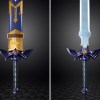 Life-size vibrating Legend of Zelda Master Sword for sale from Nintendo【Photos】
Life-size vibrating Legend of Zelda Master Sword for sale from Nintendo【Photos】 Studio Ghibli releases free-download board game — Here’s how to play it without reading Japanese
Studio Ghibli releases free-download board game — Here’s how to play it without reading Japanese Princesses, fruits, and blacksmiths: Study reveals the 30 most unusual family names in Japan
Princesses, fruits, and blacksmiths: Study reveals the 30 most unusual family names in Japan Sega has been using a different logo in Japan and overseas for years, and hardly anyone noticed
Sega has been using a different logo in Japan and overseas for years, and hardly anyone noticed Old-School console war reignites: Sega releases mini Mega Drive/Genesis against tiny Nintendo NES
Old-School console war reignites: Sega releases mini Mega Drive/Genesis against tiny Nintendo NES Retro freak: the new system that lets you play cartridges from 11 different classic game consoles
Retro freak: the new system that lets you play cartridges from 11 different classic game consoles Sega Fans Rejoice! Limited Edition Mega Drive, Saturn, Dreamcast-Themed Laptops on Sale Now!
Sega Fans Rejoice! Limited Edition Mega Drive, Saturn, Dreamcast-Themed Laptops on Sale Now! Two Sega fans get married in Japan, win at weddings with awesome Mega Drive wedding cake【Pics】
Two Sega fans get married in Japan, win at weddings with awesome Mega Drive wedding cake【Pics】 Sega’s old arcades are making money again as new owners announce 3.175-billion yen profit
Sega’s old arcades are making money again as new owners announce 3.175-billion yen profit Feud with boy band talent agency might spell the end of Sega’s Judgement video game series
Feud with boy band talent agency might spell the end of Sega’s Judgement video game series Pretend you’re Sony or Nintendo as you devour Sega with Tokyo’s new Sega Logo-yaki sweet
Pretend you’re Sony or Nintendo as you devour Sega with Tokyo’s new Sega Logo-yaki sweet Japanese man collects every single Sega Saturn game
Japanese man collects every single Sega Saturn game Sega’s troubles continue as parent company asks hundreds of employees to to quit their jobs
Sega’s troubles continue as parent company asks hundreds of employees to to quit their jobs Happy birthday, Famicom! The console that bought video games back from the dead turns 31 today
Happy birthday, Famicom! The console that bought video games back from the dead turns 31 today All aboard the Sega Train! Tokyo rail operator decorates carriages for Sonic’s 25th anniversary
All aboard the Sega Train! Tokyo rail operator decorates carriages for Sonic’s 25th anniversary You Can (Not) Lose with Sega’s Newest Evangelion Promotion
You Can (Not) Lose with Sega’s Newest Evangelion Promotion
Leave a Reply